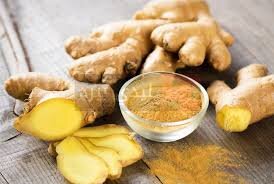Each month we showcase a different spice, write up some information about the spice and then its over to you to come up with your tips, tricks or recipes using the spice. There is a food related prize for the most interesting idea or recipe (to be posted anywhere in the world, customs permitting). Just add your ideas to this thread or if you have a recipe, then post it as a new thread and tag it ‘cookingbites spice challenge'. This month, the featured spice is ginger. Deadline for entries midnight Friday 1st September (BST).

Cultivation
Native to Southeast Asia but now widely cultivated, ginger is an upright tropical plant which has lance shaped leaves and yellow flowers. It is the root, or ‘rhizome’ which we know as the spice ‘ginger’. Large crops are grow in India, China, Taiwan, Nigeria, Jamaica and Mauritius. Australia is also a significant producer. Much of the ginger produced is sun-dried and found to a powder but there has been a steadily increasing market in the West for fresh ginger roots.
Aroma and flavour
Ginger varies considerably in flavour, depending on where it is grown. Fresh ginger is l with lemony with woody, earthy undertones and a warm heat. Australian ginger is said to be the most lemony tasting. Jamaican ginger is much richer and more pungent. Powdered ginger tends to lose some of the lemony flavour but still retains the heat.
Health benefits
Ginger is widely believed to have medicinal properties for treating all kinds of ailments including improving circulation, curing indigestion and as a cure for travel sickness. Gingerol is the main bioactive compound in ginger, responsible for much of its alleged medicinal properties. Ginger is reputed to have powerful anti-inflammatory and antioxidant effects
Culinary use
Ginger is used in a multitude of dishes around the world as both a sweet and savoury ingredient. It is available fresh, dried, pickled, ground, candied and preserved in syrup. In its ground and candied forms it is often used in baking and sweet pastries. Fresh ginger is used widely in Indian curries, Asian stir-fries, Middle Eastern dishes, and Jamaican jerk dishes (to name but a few).
But now its over to you. How do you use ginger? Tell us your ideas, tips and recipes for using ginger. Deadline for entries is midnight Friday 1st September 2017 (BST)

Cultivation
Native to Southeast Asia but now widely cultivated, ginger is an upright tropical plant which has lance shaped leaves and yellow flowers. It is the root, or ‘rhizome’ which we know as the spice ‘ginger’. Large crops are grow in India, China, Taiwan, Nigeria, Jamaica and Mauritius. Australia is also a significant producer. Much of the ginger produced is sun-dried and found to a powder but there has been a steadily increasing market in the West for fresh ginger roots.
Aroma and flavour
Ginger varies considerably in flavour, depending on where it is grown. Fresh ginger is l with lemony with woody, earthy undertones and a warm heat. Australian ginger is said to be the most lemony tasting. Jamaican ginger is much richer and more pungent. Powdered ginger tends to lose some of the lemony flavour but still retains the heat.
Health benefits
Ginger is widely believed to have medicinal properties for treating all kinds of ailments including improving circulation, curing indigestion and as a cure for travel sickness. Gingerol is the main bioactive compound in ginger, responsible for much of its alleged medicinal properties. Ginger is reputed to have powerful anti-inflammatory and antioxidant effects
Culinary use
Ginger is used in a multitude of dishes around the world as both a sweet and savoury ingredient. It is available fresh, dried, pickled, ground, candied and preserved in syrup. In its ground and candied forms it is often used in baking and sweet pastries. Fresh ginger is used widely in Indian curries, Asian stir-fries, Middle Eastern dishes, and Jamaican jerk dishes (to name but a few).
But now its over to you. How do you use ginger? Tell us your ideas, tips and recipes for using ginger. Deadline for entries is midnight Friday 1st September 2017 (BST)


